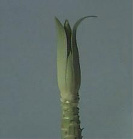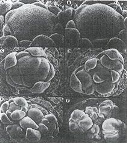Leaf Counting is a big aid to better crop timing
In the past years lily timing was started when the grower either saw buds or could "feel" them in the top of the plant. It requires approxmately 5-6 weeks at 60 degrees from buds visible until lilies flower or can be shipped. Leaf counting allows an additional 3 to 5 weeks over which temperatures can be modified in order to time the crop, an important amount of time.
How do I use leaf counting to time my crop?
Flower buds form in Easter lilies in mid-January to early February depending on planting time and temperature. Flower initiation is marked by the first indication of stem roots. At this time the leaf counting process can begin.
|
First count (and remove) all unfolded leaves. The photo at right shows a stem with all unfolded leaves removed leaving only "folded leaves". The last leaf tip is at a 45 Degree angle and is an easy leaf to reference as a marker. For instance say 40 leaves have unfolded. Now the number of leaves yet to unfold will determine the length of time necessary to have buds visible. Remember, when buds are visible you will need another 5-6 weeks of forcing. |
 |
||||||
 |
||||||||
|
The way to determine the leaves yet to unfold is to carefully count the leaves from the leaf tipped 45 degrees down to the growing point where flower buds will be found if they are initiated. The photo at left show what the flower bud primordia look like. the second picture in the second row is about the first sure sign of buds. |
||||||||
|
A mounted hand lens or a binocular microscope will be necessary for this job in the January period. Later buds are visible to the naked eye. |
Now that you know the number of leaves yet to unfold, how do you relate that to making decisions to time the crop?
Leaf counting to determine timing
Lets suppose that your counts show 40 leaves already unfoled and 45 leaves are yet to be unfolded. The numbes of leaves per day to unfold is dependent largely on temperature. Larger bulbs unfold leaves slightly faster then small bulbs, and sunlight, root condition ect. affect unfolding rates but terperture is the primary factor. The following unfolding rates a various temperatures are approximite.
70 degrees F= 1.8 leaves per day, 65 degrees F=1.5 leaves per day, 60 degrees F=1.25 leaves per day.
We seldom see rate above 2 leaves per day even above 70 degrees F and below 60 degrees rates drop rapidly.
Assume Easter is April 20, and your ship date is April 11. You want to see buds 42 days before April 11 or February 28. You mad a leaf count on January 25 and found 45 leaves to unfold. There are 34 days between January 25 and February 28. Therefore if you divide 45 leaves by days you see that you can unfold 1.3 leaves per day and see buds on February 28. You would grow your plants at night temperature just above 60 degrees F average temperatures.
Unfolding Rates can be monitored
Remember the leaf bent out at a 45 degree angle? by marking leaves at that stage about every 3-5 days on the same plant, the progress of leaf unfolding rate can be readily seen. Leaves can be marked with a sharpie ink pen or by notching or punching a hole in the leaf. If the unfolding rate is not high enough, raise the temperature or lower it if unfolding too fast.